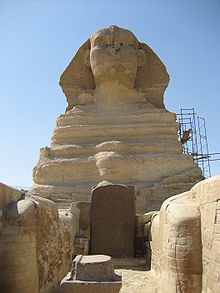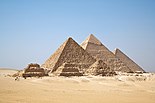The text is fragmented, with a large asymmetrical crack beginning at the twelfth line and resulting in only partial preservation of the following two lines. The stele is preserved to a height of approximately 4 feet (1.2 m) on the left edge and 5.4 feet (1.6 m) on the right. Given its restored height was some 12 feet (3.7 m), approximately half of the text is now missing. [4] The preserved text runs as follows:
Year I, third month of the first season, day 19, under the Majesty of Horus, the Mighty Bull, begetting radiance, (the Favourite) of the Two Goddesses, enduring in Kingship like Atum, the Golden Horus, Mighty of Sword, repelling the Nine Bows; the King of Upper and Lower Egypt, Men-kheperu-Ra, the Son of Ra, Thothmes IV, Shining in Diadems; beloved of (Amon), given life, stability and dominion, like Ra, for ever.
Live the Good God, the Son of Atum, Protector of Hor-akhty, Living Image of the All-Lord Sovereign, Begotten of Ra, Excellent Heir of Kheperi, beautiful of face like his father, who came forth equipped with the form of Horus upon him, a King who... favour with the Ennead of the Gods; who purifies Heliopolis, who satisfies Ra; who beautifies Memphis, who presents Truth to Atum, who offers it to Him who is South of his Wall (Ptah), who makes a monument by daily offering to the God who created all things, seeking benefits for the Gods of the South and the North, who builds their houses of limestone, who endows all their offerings, Son of Atum of His Body, Thothmes IV, Shining in Diadems like Ra, Heir of Horus upon His Throne, Men-kheperu-Ra, given life.
When His Majesty was a stripling, like Horus, the Youth in Khemmis, his beauty was like the Protector of His Father, he seemed like the God himself. The army rejoiced because of love for him, and he repeated the circuit of his might like the Son of Nut and all the princes and all the great ones...
Behold, he did a thing which gave him pleasure upon the highlands of the Memphite Nome, upon its southern and northern road shooting at a target with copper bolts, hunting lions and the small game of the desert, coursing in his chariot, his horses being swifter than the wind, together with two of his followers, while not a soul knew it.
Now, when his hour came for giving rest to his followers, it was always at the Setepet (Sanctuary of Hor-em-akhet), beside Seker in Rostaw, Rennutet in Iat-Ta-Mut(?)... in the desert (or necropolis), Mut of the Southern... (Neit?), Mistress of the Southern Wall. Sekhmet, presiding over the Mountain, the Splendid Place of the Beginning of Time, opposite the Lords of Kher-ahah (Babylon), the sacred road of the Gods to the Western Necropolis of Iwn (Heliopolis).
Now, the very great statue of Kheperi rests in this place the great in power, the splendid in strength, upon which the shadow of Ra tarries. The quarters of Memphis, and all the cities which are by him come to him, raising their hands for him in praise to his face, bearing oblations for his Ka.
One of those days it came to pass that the King's Son Thothmes came, coursing at the time of mid-day, and he rested in the shadow of this Great God. Sleep seized him at the hour when the sun was in its zenith, and he found the Majesty of this Revered God speaking with his own mouth, as a father speaks with his son, saying: 'Behold thou me, my son, Thothmes. I am thy father, Hor-em-akhet-Kheperi-Ra-Atum; I will give to thee my Kingdom upon earth at the head of the living. Thou shalt wear the White Crown and the Red Crown upon the Throne of Geb, the Hereditary Prince. The land shall be thine, in its length and in its breath, that which the eye of the All-Lord shines upon. The food of the Two Lands shall be thine, the great tribute of all countries, the duration of a long period of years. My face is directed to you, my heart is to you; Thou shalt be to me the protector of my affairs, because I am ailing in all my limbs. The sands of the Sanctuary, upon which I am, have reached me; turn to me in order to do what I desire. I know that thou art my son, my protector; behold; I am with thee, I am thy leader.'
When he finished this speech, the King's Son awoke, hearing this..., he understood the words of the God, and he put them in his heart. He said: 'Come, let us hasten to our houses in the city; they shall protect the oblations for this God which we bring for him (or that we shall protect... and that we may bring): oxen... and all young vegetables; and we shall give praise to Wennefer... Khafra, the statue made for Atum-Hor-em-akhet...' [5]
The rest of the text likely gave Thutmose's response and an affirmation of the works carried out. [4]




